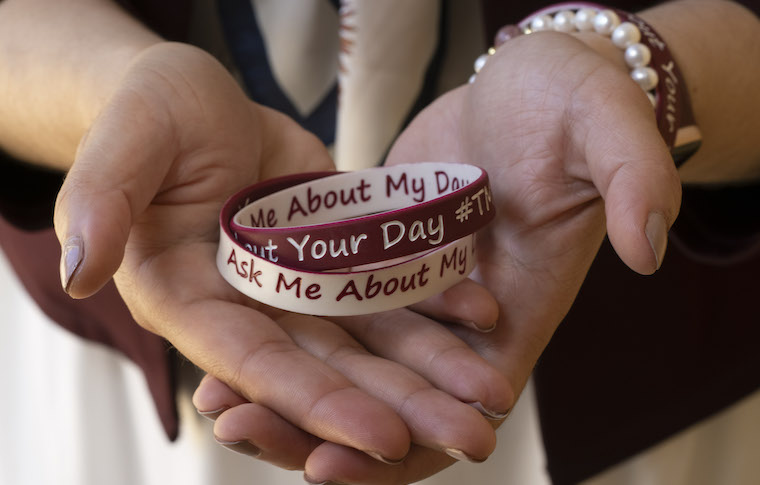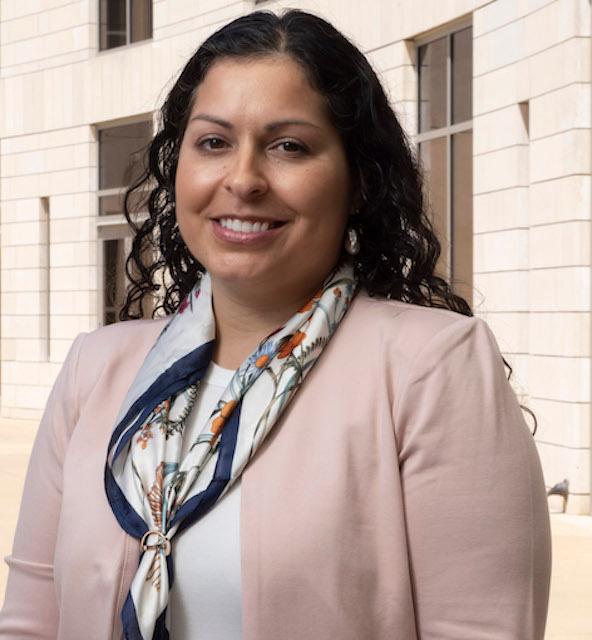
‘Ask Me, Tell Me’ Wristband Project Hopes to Build Community and Connection Through Conversations
“We all have an important role to play,” says Assistant Professor Hooria Jazaieri.
Whenever she’s on campus, Kelly Walsh ’23 wears her “Tell Me, Ask Me” wristband on her backpack to share and support its message of caring about everyone’s well-being at Santa Clara.
Max Lam ’23 keeps his on his desk as a reminder of the importance of checking in with friends about how both his and their daily lives are going.
And Lucas Ragen ’22, a proud and vocal mental health proponent at Santa Clara, wore his every day during the spring quarter before graduation—and even through summer. He’d also made sure all 107 members of his Sigma Chi fraternity, where he was president, had a wristband, too.
Now, as classes resume at Santa Clara for the fall quarter, the University is giving all 1,850 new first-year and transfer students the same wristband with its dual message: “Tell Me About Your Day #TMAYD, Ask Me About My Day #AMAMD,” as a way of cultivating and strengthening community at Santa Clara.
“It’s the idea that we can build community and connection with each other by opening up real, authentic conversations around how we’re actually doing. That’s my hope,” says assistant professor of management Hooria Jazaieri, M.A. ’10, who introduced the wristband initiative after noticing how students in one of her classes during winter quarter were struggling mentally. She also knew how the loss of four students’ lives over the past year had overshadowed them.
“It just reminded me that we all have an important role to play in the mental health and well-being of the students on our campus,” says Jazaieri, who teaches a class on social psychology of leadership and management of organizations. “We talk about knowing what your values are, and not just knowing what they are, but actually setting an example with your values,” she says. “Kind of ‘walking the walk.’”
Upsides to sharing
Inspired in part by a recent study she helped to write about bonding with others, Jazaieri’s wristbands include instructions already inscribed on both sides: One side alerts people that you’re open to having conversations with them about their day, positive, negative or otherwise; flip it over, and the other side tells them you’re open to talking about your day with someone.
“I think there are a lot of upsides to sharing,” says Jazaieri, who also is a licensed psychotherapist. “While it may feel intimidating, or for some people, they may feel anxious about talking with other people, I like to think that Santa Clara is a wonderful environment to experiment, to sort of try on new and different things.
“From my experience here, people are kind and understanding and caring.”

Assistant Professor Hooria Jazaieri
SCU administrators are providing the wristband as part of several efforts to transform mental health services for students. They’re not only backing its distribution to first year students and transfers, but to anyone on campus, as more wristbands become available this fall in a variety of locations.
“Santa Clara is committed to promoting social connections and creating a sense of belonging for our students,” says Jeanne Rosenberger, Santa Clara’s Vice Provost for Student Life, who last spring learned about Jazaieri’s research that explored how sharing emotional experiences can create opportunities for building community.
“She explained the wristband project and how she has used the project in her courses,” Rosenberger says. “The idea of engaging students in conversations about their day, as a way of making connections with others, aligns with our commitment to connect students throughout the SCU community.”
In addition to introducing the wristbands during Welcome Weekend, Jazaieri also made a short video to share with faculty who are interested in incorporating the wristband project into their classes. And she’ll be working with the Center for Student Involvement to administer a brief survey to gather feedback on the initiative.
Student endorsements
Jazaieri’s former students who received the initial wristbands were thrilled to hear that the bands are now being handed out to first-years and transfers.
“I love that!” says Ragen, who is now working for a tech sales company in San Diego. “It’s a very small act, just something you wear on your wrist. It might not promote conversation for some people, but over time, I think it will create community from the bottom up.”
De-stigmatizing the issue of mental health is something Ragen championed after having a relative struggle with the issue. It became a mission of sorts for him at Santa Clara, and as president of his fraternity house, where he says he promoted well-being within Sigma Chi, as well as the Greek community.
“I wanted it for my entire chapter because we care about each other a lot,” he says, “and I really just wanted to show that we’re available to others as well.”
For Walsh, the second of four sisters to attend Santa Clara, the wristbands from Jazaieri, and the extras she got for her housemates, represent a powerful symbol of support.
“It’s a line of communication between students, faculty, and everyone, that you can start the conversation and feel comfortable,” says the senior who, like many in her class, sometimes felt isolated off campus during the pandemic.
Which is why she appreciates Jazaieri’s wristband project so much. “It has the potential to spread awareness. It’s something you wear, it’s visible. Like a sweatshirt. If someone asks you about it, it becomes a conversation starter,” says Walsh, who says the wristband on her backpack has encouraged others to inquire about it. “And that’s what it’s supposed to do.”
Learning to adjust in order to thrive
Like others, Lam had asked the assistant professor for an extra set for a friend. While he understands that not everyone may be receptive to the idea, the senior believes he benefited from it.
“You didn’t have to use them, but they’re a good way of expressing, in a non-verbal way, the well-being of our community. I think these wristbands will open up a lot of doors for people, and help them communicate with each other in an effective way.”
If Lam has one message for first year SCU students, it’s that “college is a very big growth spike, and with any growth spike, there are growing pains,” he says. “You’re away from home and in a new environment, and you’re having to learn to adjust in order to thrive.”
He points to the deep disappointment of being turned down by a campus student professional club he had tried to join, something Lam believed was vital to his future, and his success.
But over time, and after many, many talks with family and friends—as well as Jazaieri— he realized that dwelling on rejection was giving power to other people over his self-worth. That prompted him to look up Alpha Phi Omega, an SCU professional service fraternity, where he was not only welcomed, but has become a leader and mentor for others.
“I decided,” Lam says, “to find other people who see the value that I see in myself.”